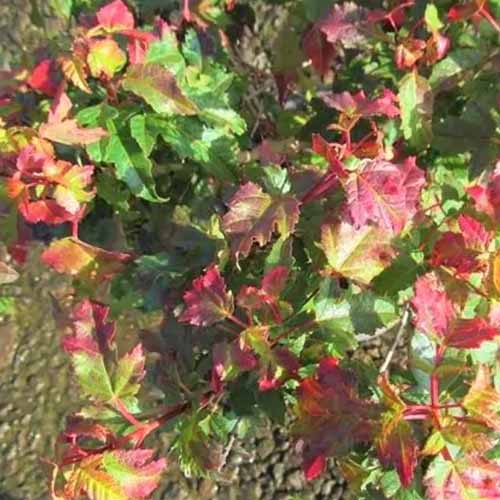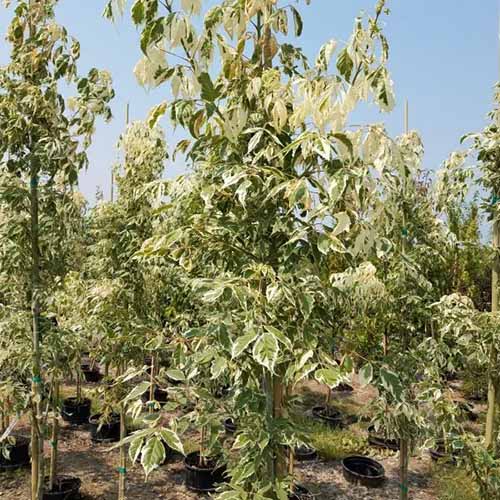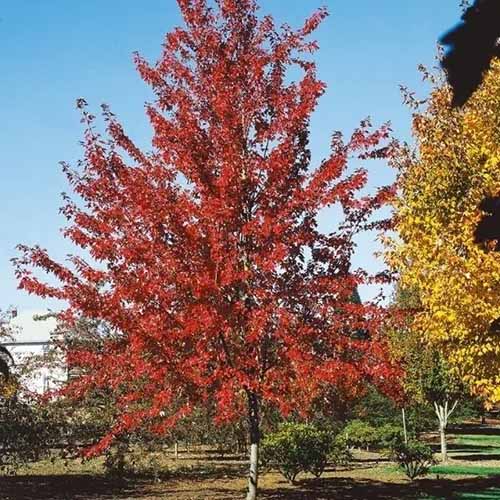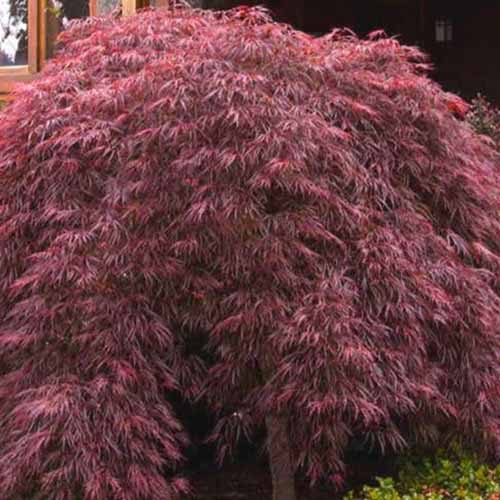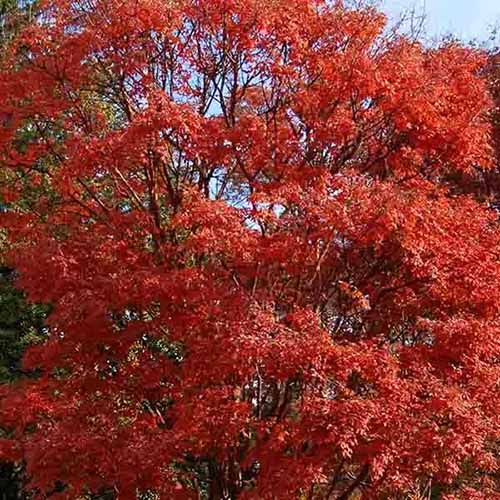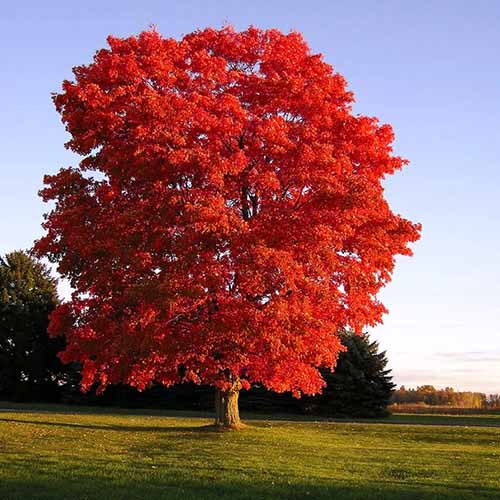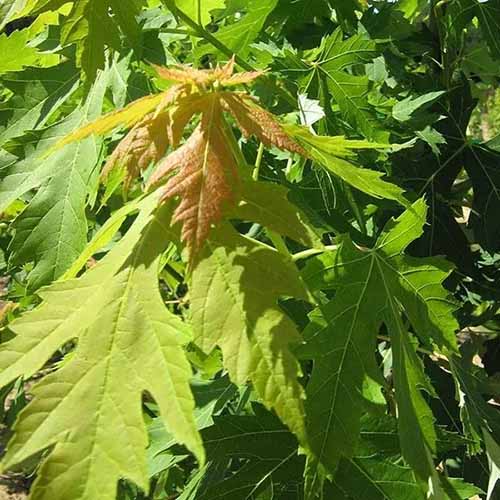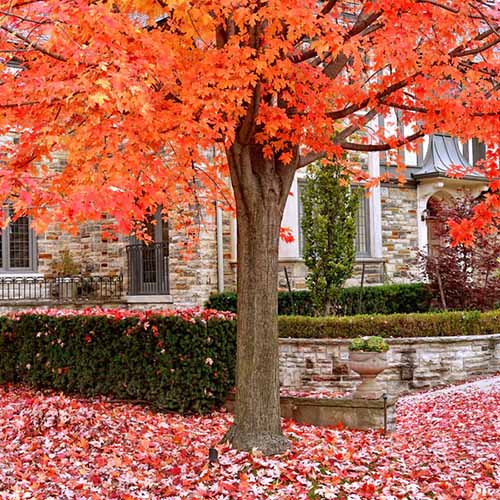Autumn is my favorite season… it’s not even close. And fall is an ideal time for a grab bag of reasons: Halloween, longer nights, the cool-without-being-freezing-weather, and so on.
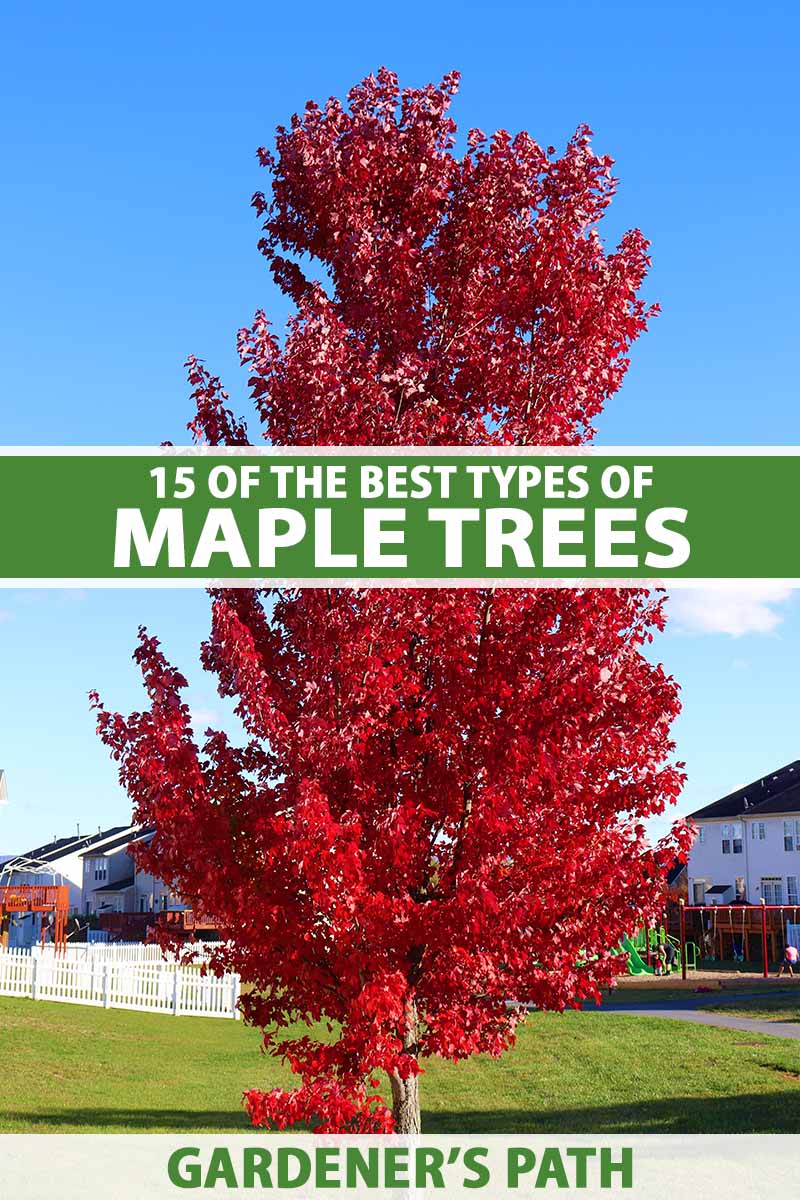
We link to vendors to help you find relevant products. If you buy from one of our links, we may earn a commission.
But my top favorite reason for loving fall? The beautiful way that the trees change color. As a dude from the Midwest with a ton of deciduous trees around, I can proudly say that my eyeballs are well and truly spoiled when the leaves start to switch shades.
Oaks, dogwoods, gingko – they’re great in the fall, don’t get me wrong. But botanically, the top color-changing trees are most definitely maples. No contest.
There are numerous species of Acer, so we wanted to whittle down the options for you, leaving you with the cream of the crop to choose from. These 15 maples aren’t perfect – no plants are. But they’re pretty dang close.
Here’s the lineup:
Species of Acer tend to grow invasively, especially ones that aren’t native to where they’re being planted. It’s definitely worth consulting your local ecological laws, if you’re concerned about spreading a potentially invasive species.
If you need a refresher on growing maple trees before we continue, check out our guide.
1. Acer x pseudosieboldianum
Let’s begin with a hybrid without a common name. This cross of A. palmatum and A. pseudosieboldianum wields the Japanese maple’s ornamental appeal in combination with the cold-hardiness of the Korean maple.
A. palmatum x pseudosieboldianum is a variety that’s perfect for those that live in USDA Hardiness Zones 4 to 5 and refuse to let their Japanese maple dreams die – we’ll go into more detail about that species a little later.
Growing 20 feet in height and 15 feet wide, this maple has foliage resembling that of A. palmatum – it starts off red, turns green in midsummer, then becomes orange-scarlet in fall.
Combined with pink samaras, this tree combines the qualities of old favorites with its own unique features.
‘Northwind’ is an especially cold-hardy variety with gorgeous pink samaras and orange-scarlet fall color, while ‘First Flame’ has foliage that emerges in spring with fiery red-orange tones.
2. Amur
Hailing from the central and northern regions of China, Manchuria, and Japan, A. ginnala – aka Amur or Siberian maple – has simple, three-lobed leaves that are up to three inches in length, with the middle lobe much longer than the lateral ones.
In plant identification classes, I remembered this species as the bird-flipping maple. Immature, perhaps… but I never got it wrong on my ID quizzes!
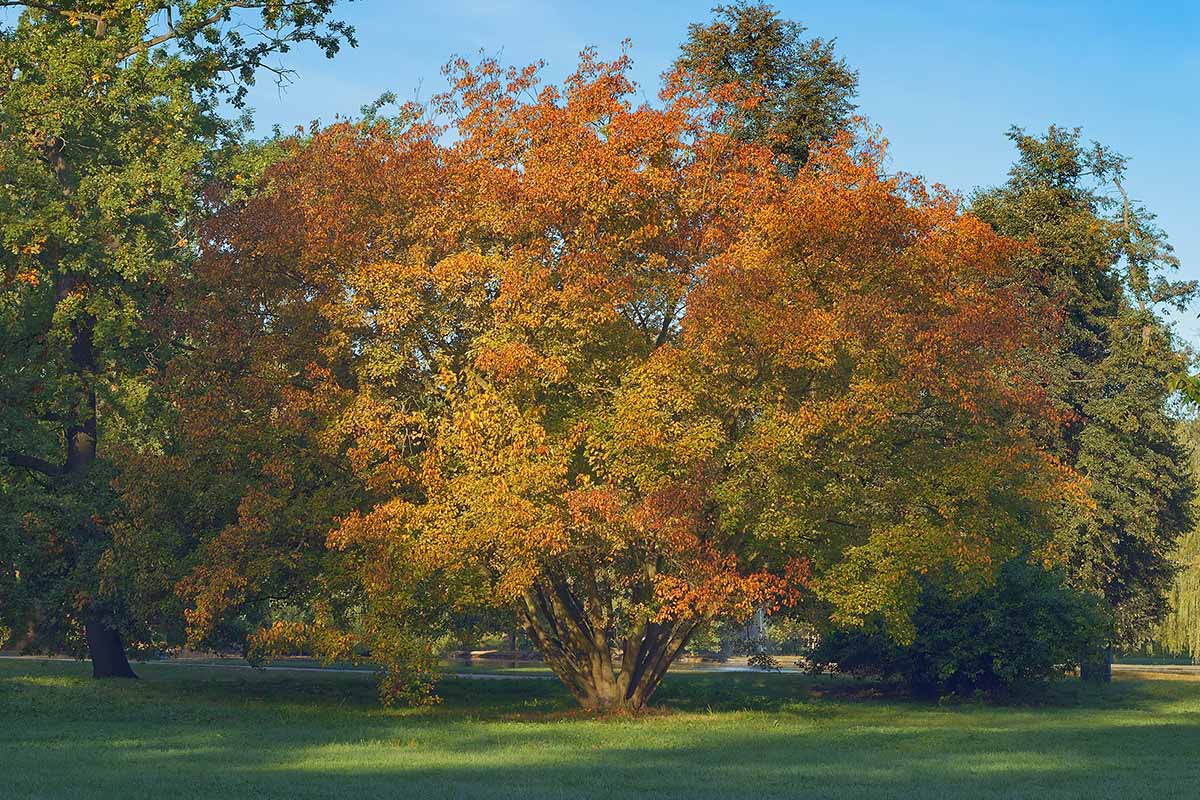
Best grown in USDA Hardiness Zones 3 to 8, this multi-stemmed tree with a clumping habit has a 15 to 20 foot height and a 15 to 30 foot spread at maturity, and is a pretty tough plant overall.
It’s easy to transplant, adaptable across a wide range of soils and exposures, and can withstand heavier pruning than other maples.
A. ginnala has glossy, dark green foliage that emerges earlier in the year than most trees, and transforms into shades of yellow, orange, and red come autumn.
The Amur maple looks great as a moderately sized specimen, hedge, or patio planting when pruned. It’s smaller and more shrub-like than other species of Acer, and it can also function well as an accent in the landscape.
There are a couple of cool cultivars worth noting. ‘Compactum’ reaches half the mature size of the species plant, with species-sized leaves that turn a dark red-purple in autumn.
The samaras and fall foliage of ‘Embers’ have an excellent red fall color, and this tree is taller than it is wide, for a change.
Nature Hills Nursery offers ‘Compactum’ at multiple levels of maturity and in various sizes.
3. Boxelder
Native to the United States, southern Canada, and Mexico, A. negundo does best in USDA Hardiness Zones 3 to 9.
Another tough species of maple, boxelder tolerates tough conditions that other plants won’t, such as a variety of soils – both wet and dry – and cold climates.

Reaching a height of 30 to 50 feet and an equal or greater spread, this tree has bright green, compound leaves with three to five leaflets, with the lower leaflets possessing thumb-like lateral ridges.
The leaves turn yellow-green to brown in autumn, so you won’t see the stunning fall color that’s typically provided by other species of Acer.
All of this in combination with a ragged, multi-stemmed habit make this tree well-suited for more natural landscaping, with placement in the middle of fields, in a natives garden, or at the edges of forests.
However, this wild appearance means it’s probably not as suited to more manicured landscapes.
All this to say, it’s still a gorgeous tree… as long as you choose your planting location wisely, and put it in an informal garden or natural-looking environment where it can visually perform the best.
Notable varieties include golden-leafed ‘Auratum,’ as well as ‘Flamingo,’ which sprouts pink shoots in the spring that grow into variegated foliage with pink margins.
Does ‘Flamingo’ tickle your fancy? Snag one from Nature Hills Nursery.
4. Freeman’s
A hybrid cross between A. rubrum and A. saccharinum, Acer x freemanii combines the strong branch attachment of the red maple with the speedy growth of the silver maple.
This hybrid also resists chlorosis in alkaline soils, which neither of its parents are capable of pulling off.
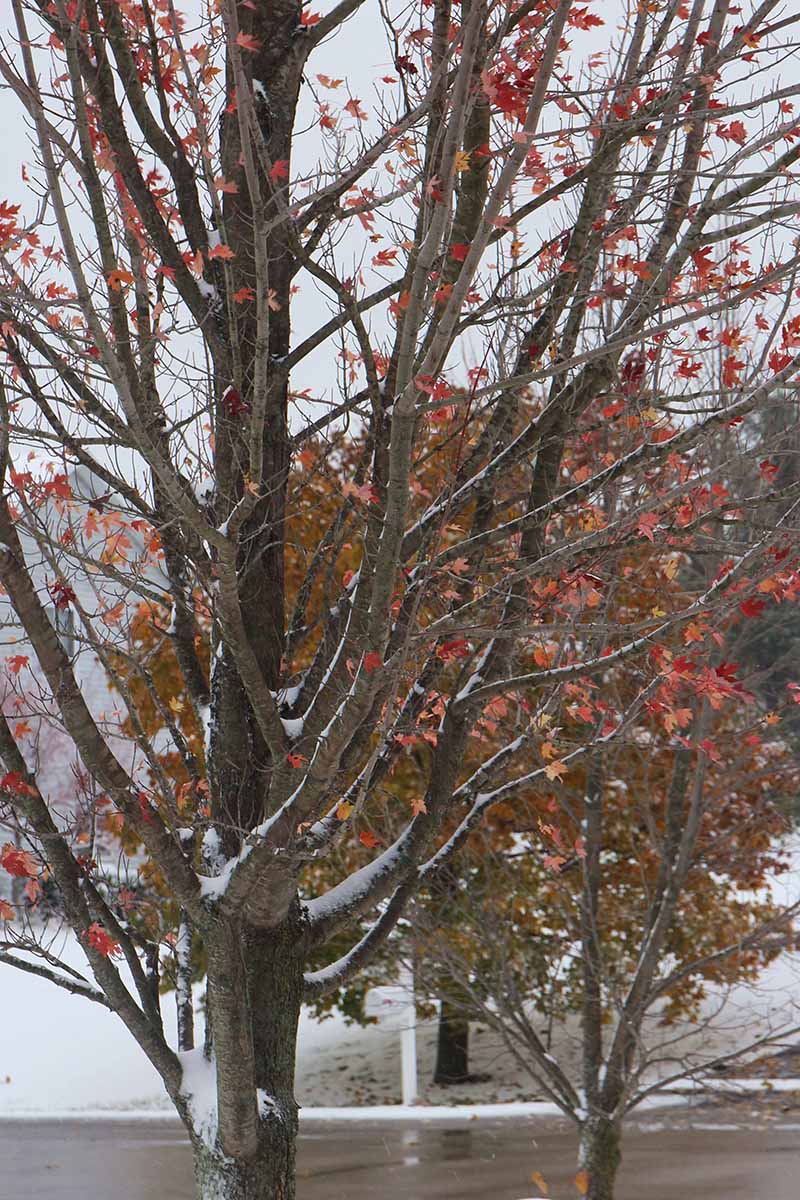
Best grown in USDA Hardiness Zones 5 to 8, Freeman’s maple reaches a height of 40 to 60 feet and a spread of 20 to 40 feet, and tolerates a variety of soil textures and moisture levels.
The leaves are three to five inches long, dark green, and deeply lobed with toothed sinuses, or spaces between the lobes. Said leaves can turn a variety of shades from red to orange to yellow in autumn, depending on the variety.
Speaking of Freeman’s maple varieties: ‘Armstrong’ is a narrow and upright cultivar that grows 50 to 70 feet tall by 15 to 20 feet wide with red-orange fall color.
‘Marmo’ also has a narrow and upright form, with fall leaves that are mottled with green, red, burgundy, and yellow colors.
‘Firefall’ features orange-red fall foliage and grows to a mature height of 40 to 50 feet.
If an Acer x freemanii sounds like the perfect plant to add to your space, then head on over to Nature Hills Nursery to pick up ‘Firefall.’
5. Hedge
A. campestre, aka the field or hedge maple, is native to Europe, Africa, and the southwestern parts of Asia.
With its best growth occurring in USDA Hardiness Zones 4 to 8, the hedge maple was introduced to the United States during colonial times, and reaches a mature height and spread of 25 to 35 feet.
Its two- to four-inch-long, attractive leaves have five rounded lobes, and its dark green foliage transforms into a gorgeous yellow in late autumn, which can be a welcome change from the usual red foliage that you tend to see from maples in fall.
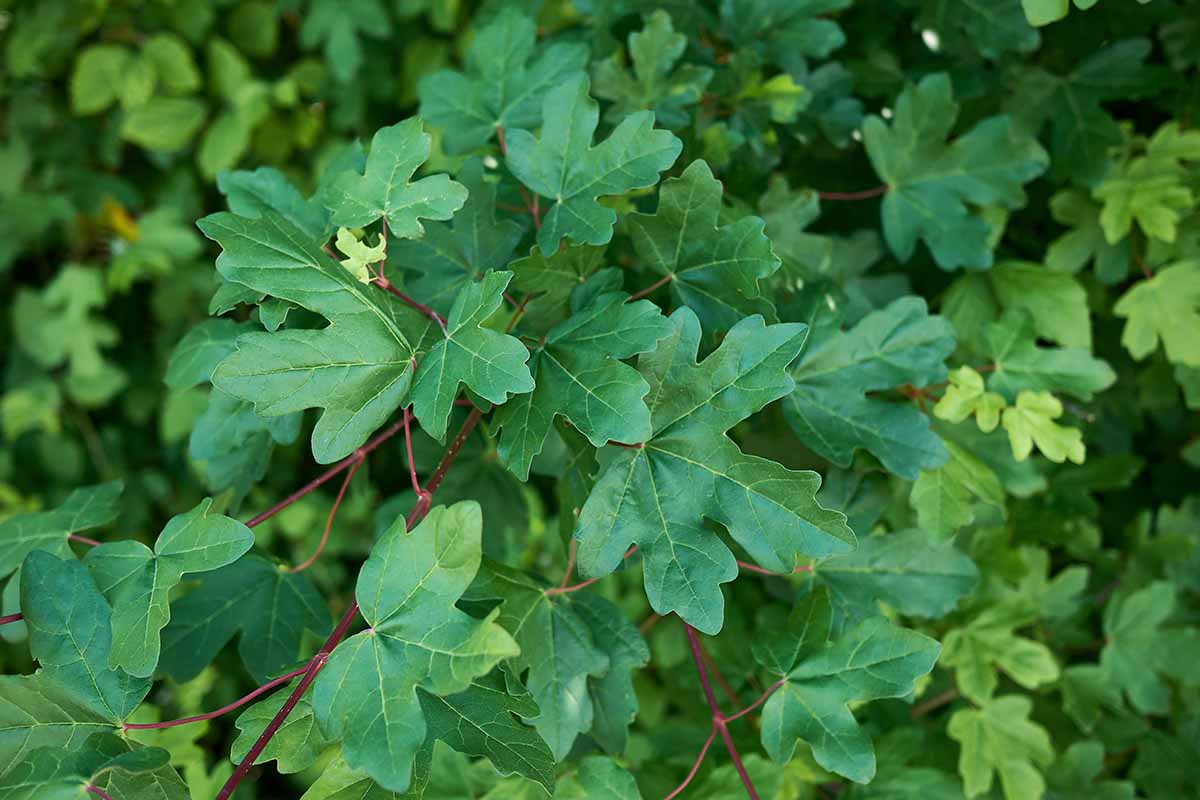
The hedge maple’s beauty has earned it a niche in the landscape as a small specimen tree, whether it’s planted in lawns or in urban areas.
The relatively small size of this tree allows it to fit in spots under utility lines that other Acer species might not fit into, and you can also plant in a group and trim these bad boys into a hedge shape.
This tree does have invasive tendencies, but not to the point of necessitating a blanket “don’t plant this” recommendation. Check your local regulations before planting this species, and keep an eye out for volunteer seedlings near your original plantings.
The ‘Metro Gold’ cultivar, aka ‘Panacek,’ grows a bit more narrowly than the species plant, with a mature height and width of 35 and 20 feet, respectively.
‘Royal Ruby’ has foliage that starts out its growth in shades of dark pinkish-red, before transitioning into its typical dark green hue.
6. Japanese
Tracing its native roots to China, Japan, Korea, and Taiwan, A. palmatum owes its common name to the fact that the Japanese people have cultivated this plant for generations.
It has since been introduced to other parts of the world like England and the United States, and grows optimally in USDA Hardiness Zones 6 to 8.
The Japanese maple can be grown as a small tree or multi-stemmed shrub while the foliage tends to be dark green during the growing season in many cases, later turning shades of purple, red, bronze, orange, and/or yellow in fall.
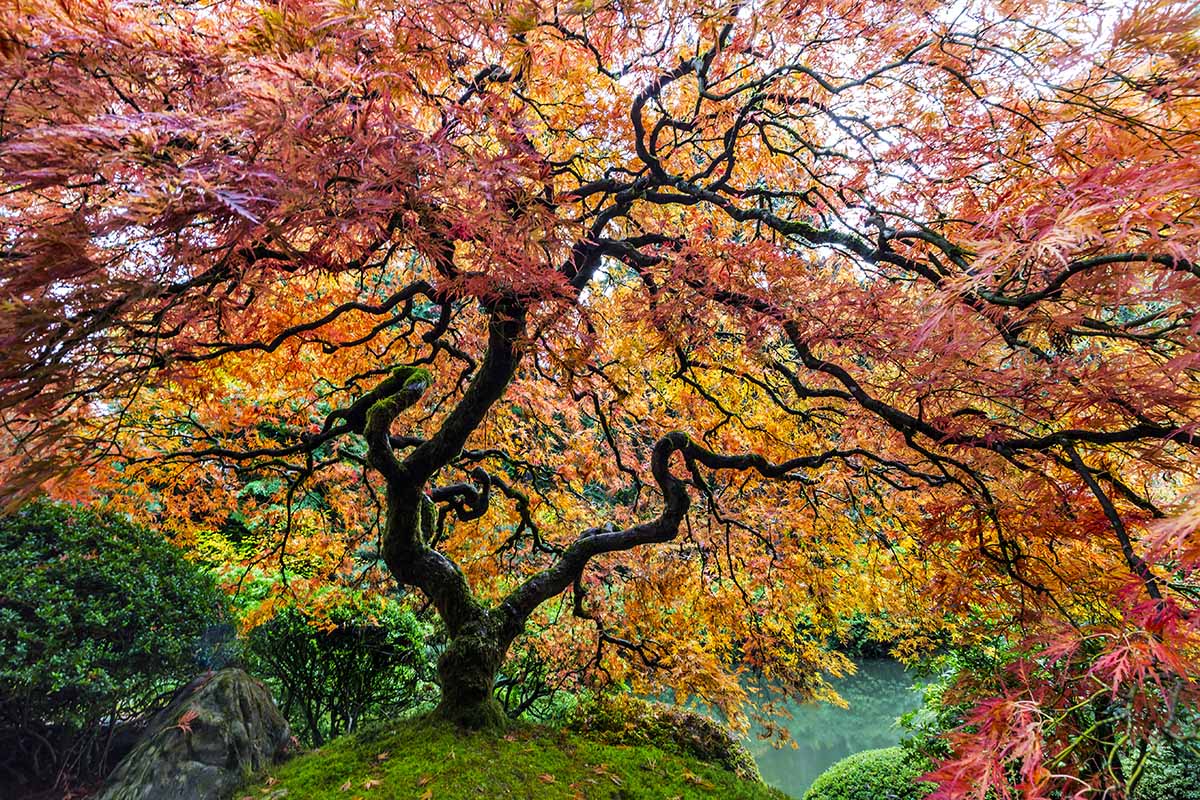
Each two- to five-inch-long leaf has five to nine deep lobes, with serrated margins. These typically reach 15 to 25 feet tall at maturity, with an equal or greater spread.
But this metric can vary significantly – some mounding varieties only attain six- to eight-foot heights, while some specimens can shoot up to 50 feet tall in the wild.
Ornamentally, this Acer species is very flexible in the landscape. Specimen, accent, shade tree, bonsai, grouping, border… whatever the role, a Japanese maple can play it.
And speaking as an American gardener in the United States, this tree brings with it a welcome splash of zen wherever it’s planted, more so than other maples.
There are almost too many cultivars to name… but as a primer, A. palmatum cultivars fall in one of two camps: those with dissected leaves and others with non-dissected leaves.
Dissected leaves are feathery, with finely cut and serrated lobes, while non-dissected foliage has smoother, broader lobes.
For a dissected leaf cultivar, ‘Crimson Queen’ has dark purplish-red leaves and a cascading growing habit. Trees are available in several sizes from Planting Tree.
If a variety with non-dissected leaves is the move for you, then check out the ‘Hogyoku’ cultivar, with its bright orange autumn foliage that turns from green to the color of ripe pumpkins in the fall.
For more information about growing Japanese maples, check out our guide.
7. Korean
Native to Manchuria, China, and Korea, A. pseudosieboldianum is pretty similar across the board to A. palmatum, save for leaves that are doubly-serrated with unevenly-sized lobes that decrease in size the closer they emerge from the stem.
With fall colors of crimson, scarlet, and orange, it’s pretty tough to tell this one apart from its Japanese relative.
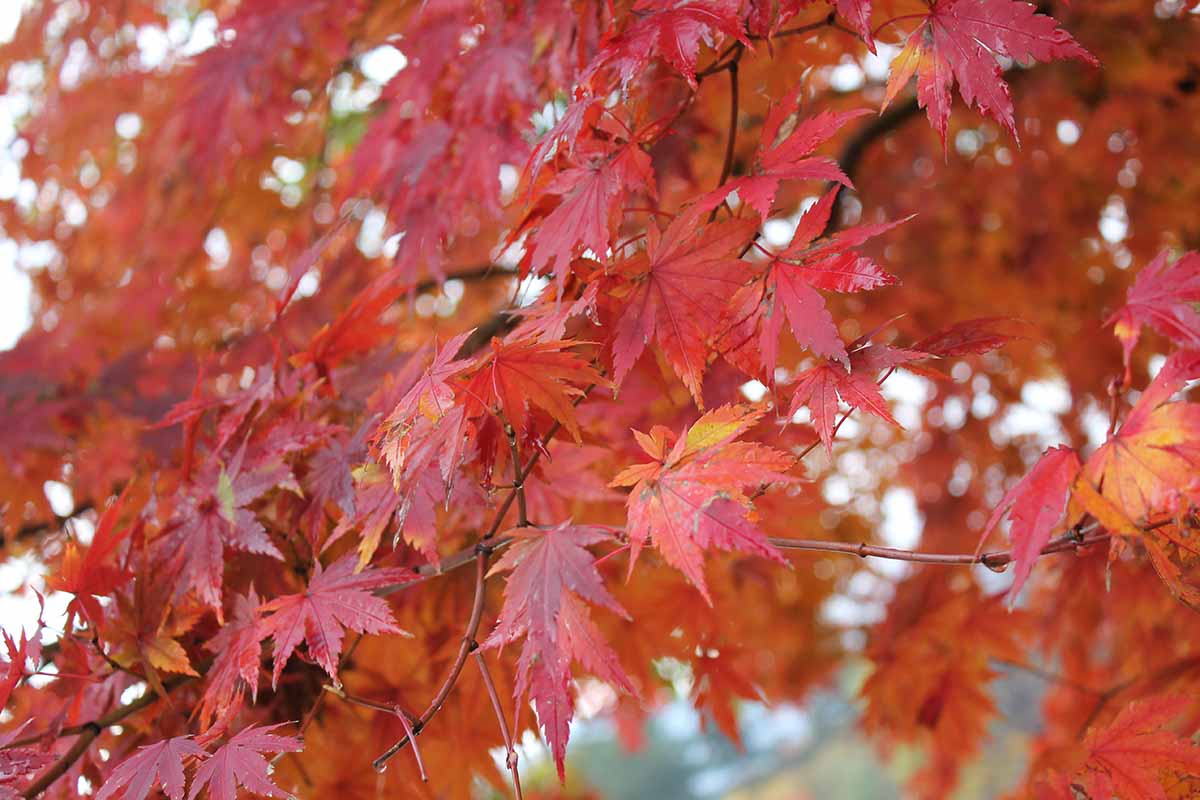
There’s no competing with a Japanese maple… but since the Korean maple optimally grows in USDA Hardiness Zones 4 to 7, this tree makes for an amazing A. palmatum substitute in Zones 4 to 5.
But a Korean maple is definitely beautiful enough to grow for its own sake!
8. Norway
Native to Norway and the rest of continental Europe, A. platanoides tend to reach 40 to 50 feet in height, with an equal or slightly smaller spread.
Best cultivated in USDA Hardiness Zones 4 to 7, the Norway maple has dark green, lustrous leaves that are four to seven inches long and wide, with five sharply pointed lobes.
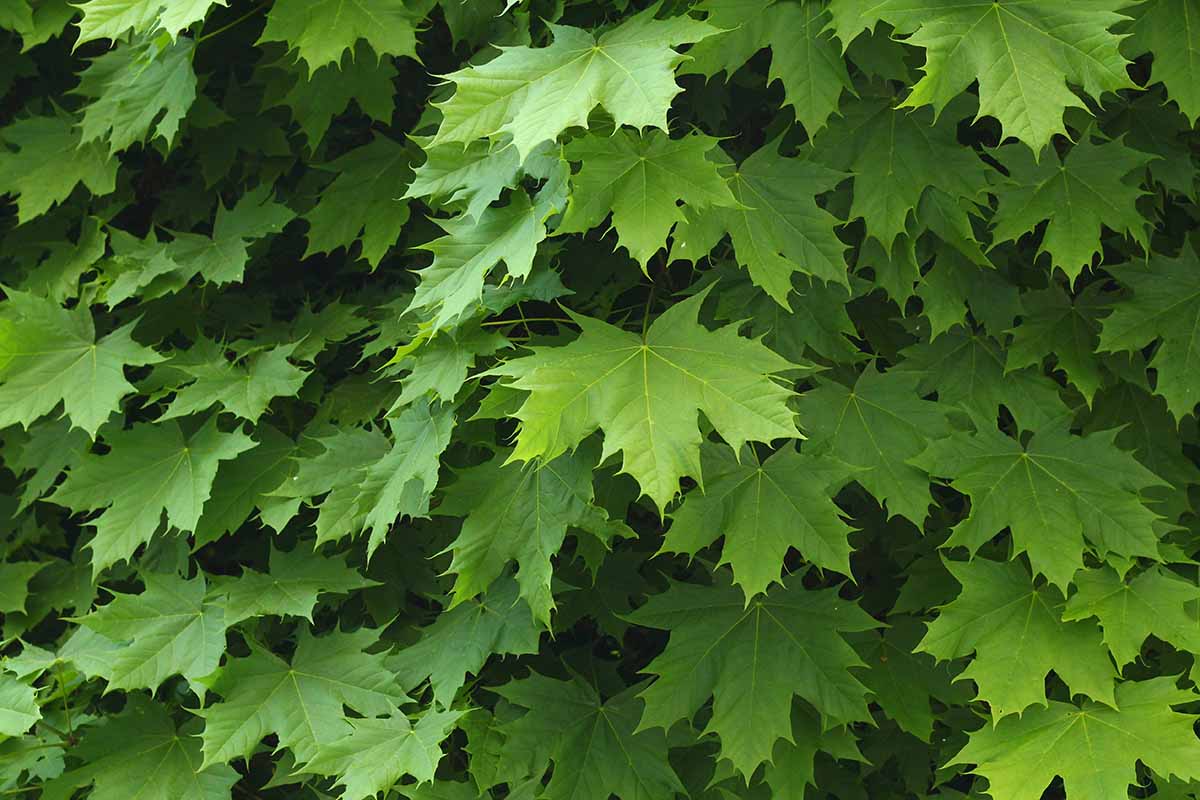
The foliage makes for a very dense and symmetrical canopy, and the tree can tolerate air pollution and many different types of soils.
Come fall, the leaves turn a gorgeous yellow, and the bark’s texture is also really interesting to look at, especially when the tree is bare in wintertime.
A. platanoides cultivars tend to perform better than the actual species. ‘Crimson King’ is a variety that has reddish-maroon leaves all throughout the growing season, which is nice if you want some foliage that isn’t green right from the get-go.
‘Emerald Queen’ is a rapidly growing cultivar that’s about half the size of the species, which makes it ideal for fitting into tight urban spots.
For a three- to four-foot-tall bare root A. platanoides, visit The Home Depot.
Find tips on growing Norway maples here.
9. Paperbark
Maples aren’t usually grown for their ornamental bark, but A. griseum is definitely an exception.
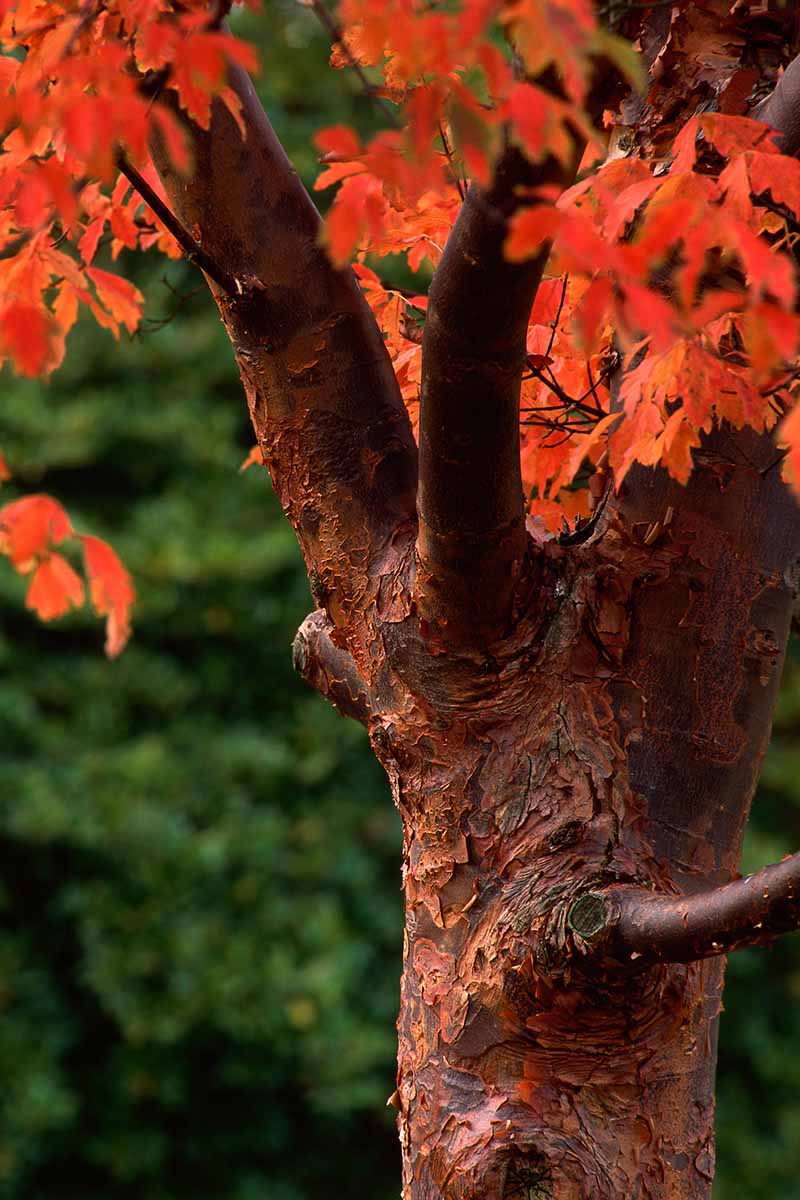
Native to central China and well-adapted to USDA Hardiness Zones 4 to 8, this multi-stemmed, clumping tree grows to be 20 to 30 feet in height, with a spread ranging from half that to an equal distance.
The leaves are trifoliate, with a dark green to bluish-green color in summer that changes to bronze or scarlet in fall.
The bark is cinnamon-colored, reddish-brown bark it peels away from the trunk in a manner similar to paper birches.
It’s a very cool look that isn’t normally seen with maple trees, and it’s the bark that truly makes this a gorgeous specimen worth adding to any maple collection.
Nature Hills Nursery has paperbark maple available for purchase.
10. Red
Hardy in USDA Zones 3 to 9 and native to central and eastern regions of North America, A. rubrum is a landscape staple over here in the New World.
Growing 40 to 60 feet in height and spread, the red maple is well known for the gorgeous shades of red that the leaves take on in fall, hence the name.
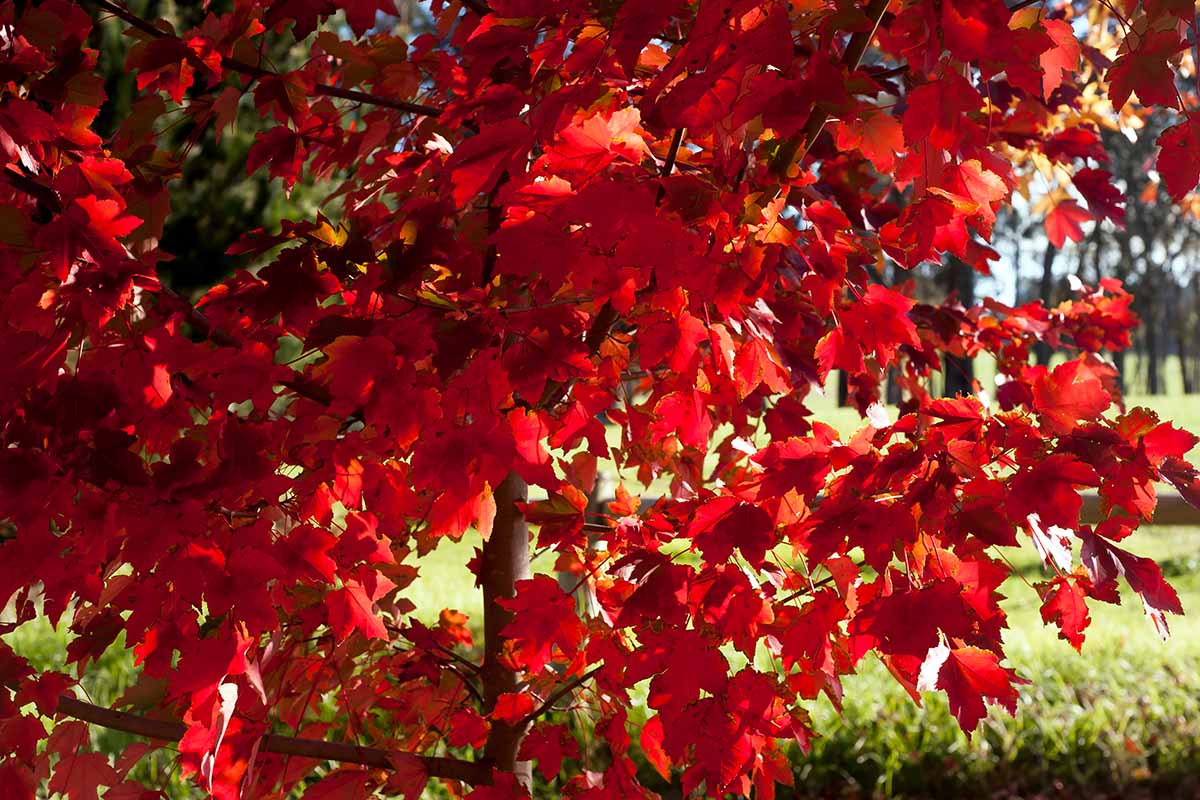
Each leaf is three- to five-lobed, with triangular lobes and red petioles.
The dense foliage provides heavy shade, making it a perfect tree to spread your blanket under for a picnic or simply to beat the heat.
Equally proficient as a specimen or a complement to other perennial plantings that might grow under its canopy, the red maple is most at home in lawns, parks, or as a street planting.
The available cultivars for this species are numerous, and tend to improve on the fall color of the species plant.
‘October Glory’ has long-lasting and brilliant red fall color that gloriously emerges in October, while ‘Red Sunset’ combines an early emergence of orange-red autumnal hues with extra cold-hardiness, all in one glorious package.
Planting Tree has four- to five-foot species plants available, while Fast Growing Trees has four to five foot ‘Red Sunset’ specimens available.
You can find ‘October Glory’ at Fast Growing Trees as well.
Learn more about cultivating and caring for this species in our guide to growing A. rubrum.
11. Shantung
An Asian native that grows best in USDA Hardiness Zones 4 to 8, A. truncatum reaches a height and spread of 20 to 25 feet, and has a notably high tolerance for urban conditions.
This tree’s habit is neatly rounded, regularly branched, and densely packed with foliage. The leaves have five to seven lobes, emerge with a purplish-red hue, mature into a glossy dark green, and change into shades of yellow-orange-red in autumn.
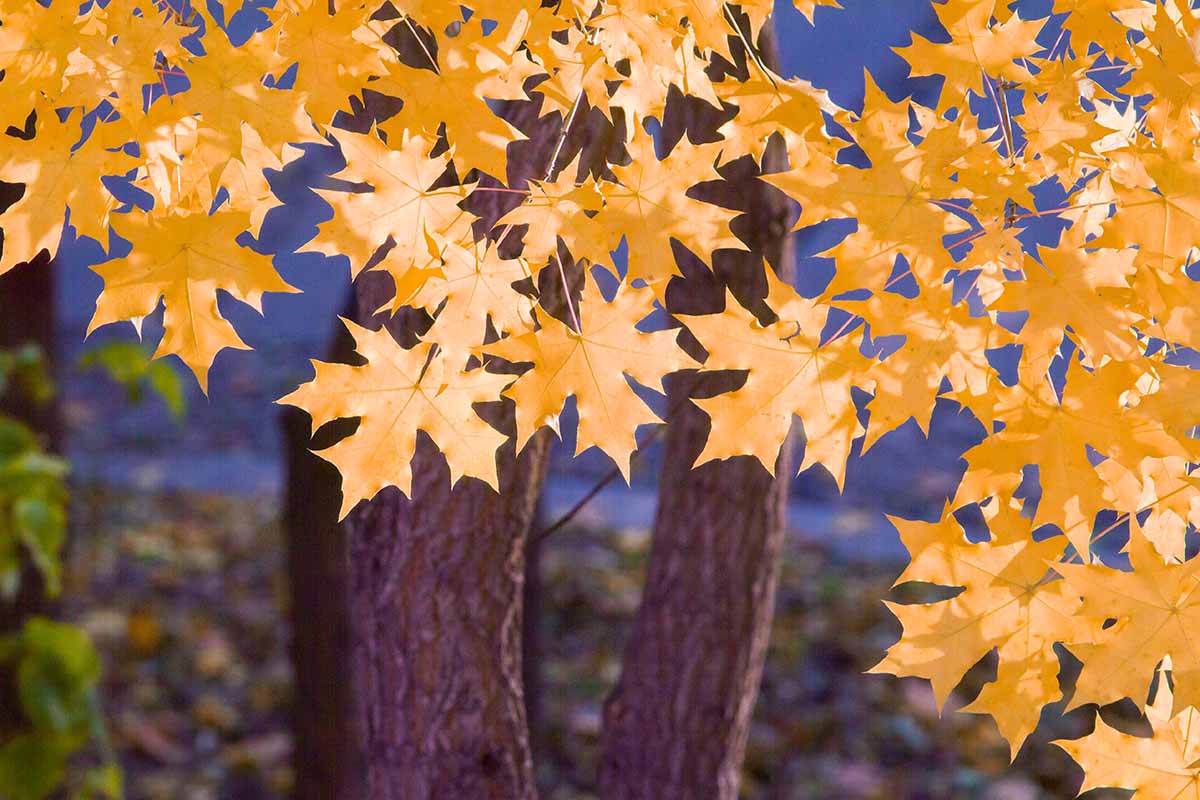
This tree definitely scratches the ornamental itch one might get for a red maple, but in a compact package that tolerates street planting well.
It’s also resistant to heat, drought, and leaf scorch, so if you’ve ever wanted a less-wimpy A. rubrum, A. truncatum is the Acer for you.
There are definitely some interesting cultivars for this one. ‘Crimson Sunset’ has year-round purple foliage, while ‘Fire Dragon’ has brilliant red fall foliage with yellow margins, along with additional tolerance for frost or freeze damage, wind, and alkaline soils.
12. Silver
Native to what can essentially be described as the eastern half of the United States and Canada, A. saccharinum reaches 50 to 70 feet in height, with a spread about two-thirds that of its vertical measurement.
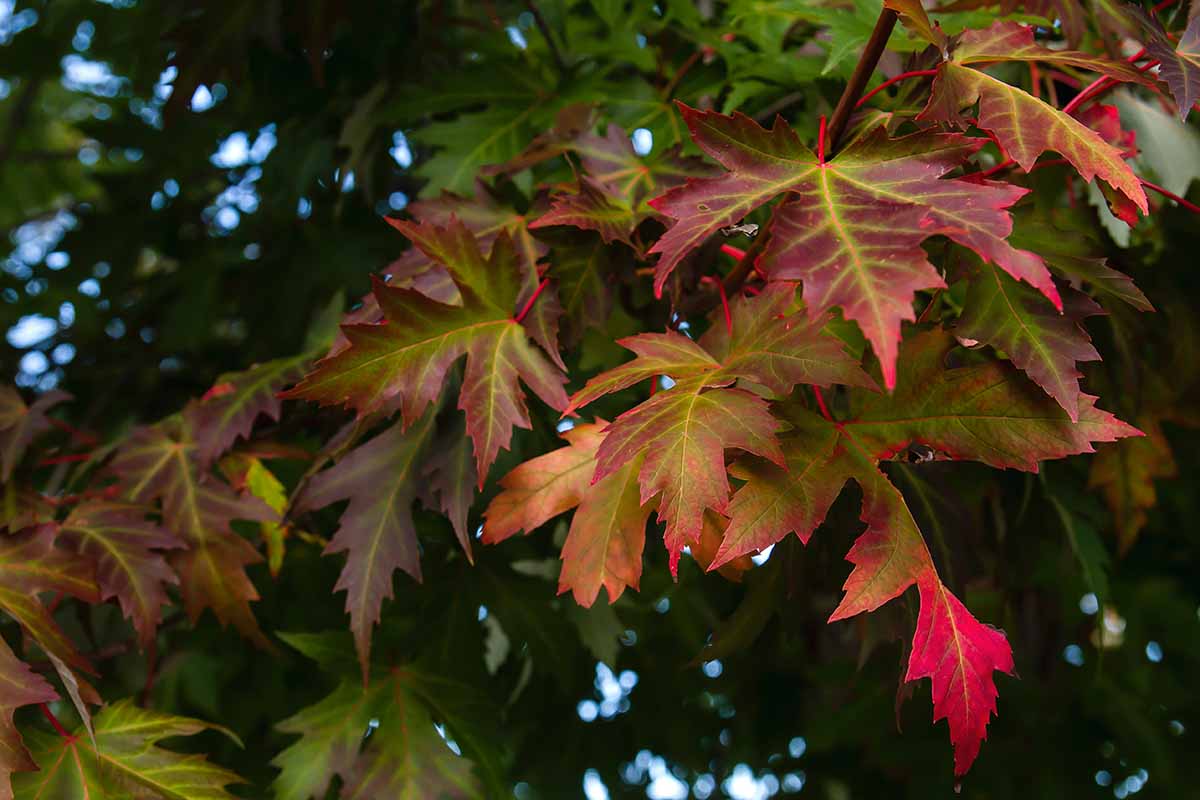
Hardy in USDA Zones 3 to 9, the silver maple is the fastest-growing maple tree in North America – two to three feet of vertical growth per year is typical in a silver maple’s early years.
This is great for when you need some shade as soon as possible, or if you simply want to be able to enjoy the full stature of a tree that you planted within your lifetime.
The leaves of A. saccharinum are five-lobed, three to six inches across, and so deeply jagged that they almost look like oak leaves. A great tip for plant identification is to check the underside of the leaves: they’ll be silver, just like their name indicates!
Silver maples can handle being planted in dry soils, but are also well-adapted to growing alongside streams or in moist forests.
If the soil in question is poor, then A. saccharinum is a great candidate, especially if you want to grow a red maple in a certain area, but can’t due to improper soil.
‘Silver Queen’ is a notable cultivar with outstanding fall color that the species lacks. Additionally, ‘Abingdon Dwarf’ is an eight-foot-tall and three-foot-wide novelty variety of silver maple, which is adorably small in comparison to a standard A. saccharinum.
Nature Hills Nursery has silver maples available for purchase.
13. Striped
A North American native that grows best in USDA Hardiness Zones 3 to 7, the striped maple is named for the greenish-white vertical stripes that streak the bark of young branches.
Growing 15 to 20 feet tall with an equal or slightly smaller spread, A. pensylvanivum is an awesome planting for naturalized landscapes.

The foliage is tri-lobed with shallow sinuses between the apex of each lobe. Striped maple leaves emerge tinted pink, mature to bright green, and become a truly striking yellow in fall.
The autumnal foliage, combined with the striped bark, give A. pennsylvanicum its ornamental edge.
These trees are a bit susceptible to heat, drought, and urban conditions, but their beauty is well worth your cultivation efforts.
An interesting cultivar is ‘Erythrocladum,’ which has coral-pink-to-red stems that are striated with white, and especially attractive when the tree is defoliated in winter.
14. Sugar
The Acer that I would argue is responsible for the success of Eggo waffles, A. saccharum is one sweet tree, both ornamentally and literally, at least as far as the sap it produces is concerned.
Native to central and eastern parts of the United States and Canada, the sugar maple is hardy in USDA Zones 4 to 8, and typically reaches mature heights of 60 to 75 feet, with a spread about two-thirds of that.
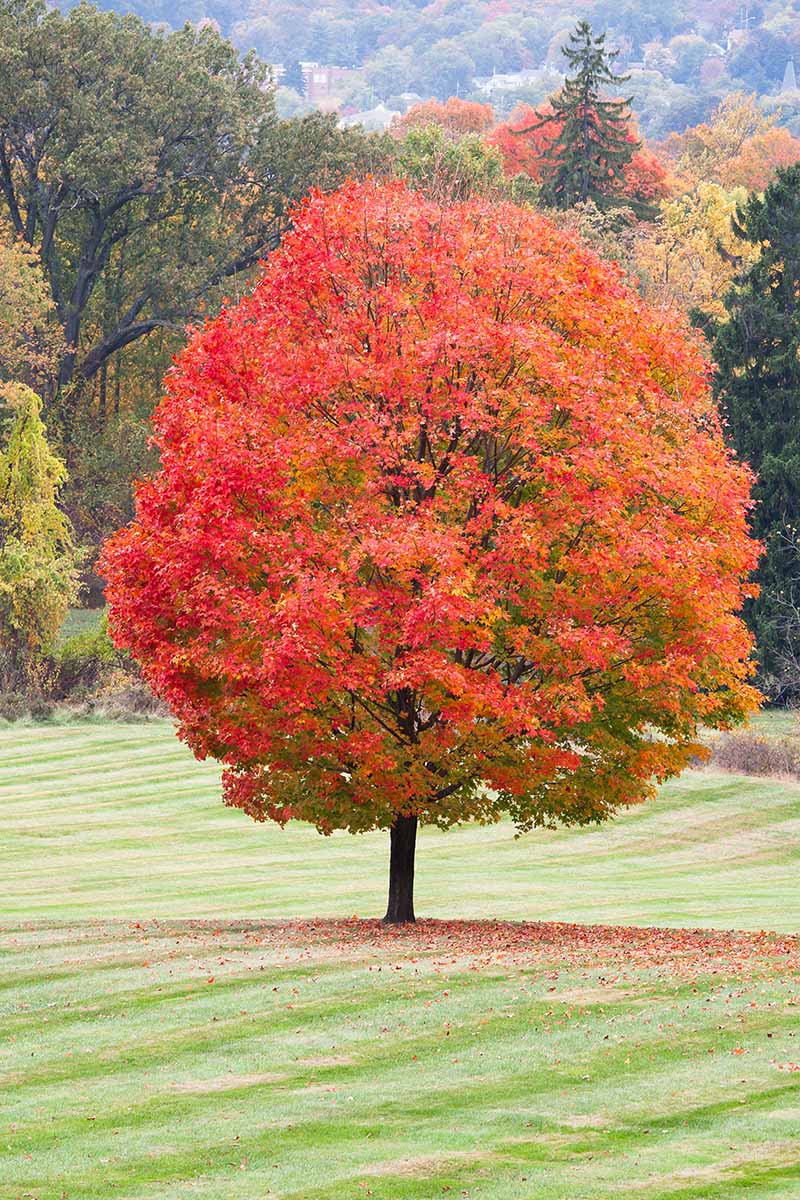
With dense foliage and a rounded oval habit, this plant’s sap has twice the sugar content of other Acer species, making it the first choice for anyone looking to harvest maple syrup – though they will have to wait awhile.
You can read more about tapping trees for syrup in this guide from our sister site, Foodal.
This tree is no slouch in the landscape, either. Ornamentally, the foliage is like the middleman between red maple and silver maple leaves, with green summer leaves that turn yellow, orange, and red in fall.
Whether it’s planted for eventual maple syrup tapping, or for use as a shade-giving specimen in wide-open spaces, the sugar maple definitely earns its keep in exchange for the required real estate in your garden.
For a pair of heat-resistant and tatter-proof varieties, check out ‘Autumn Splendor’ and ‘Oregon Trail.’ The former has orange-red leaves in fall, while the latter’s autumn foliage is more of a straight-up red.
Planting Tree has the standard species available.
For more info on cultivating sugar maple, check out our guide.
15. Tatarian
Native to southeastern Europe and western Asia, A. tataricum is best grown in USDA Hardiness Zones 3 to 8. With a height and spread of 15 to 20 feet, the Tatarian maple is tolerant of alkaline soils and has no serious diseases or insect problems to note.
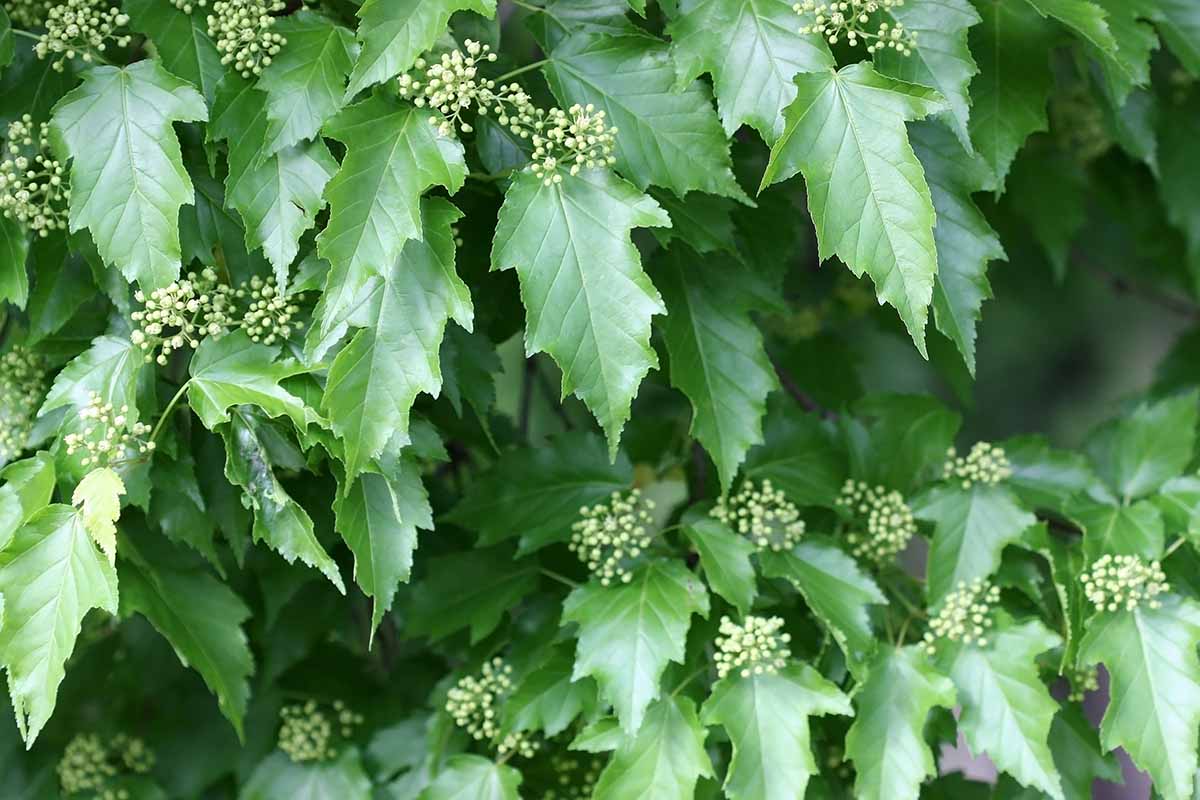
That’s not to say that this species is immune to problems, but with proper care, it’s a variety known for its hardiness.
The mature leaves on this maple are unlobed, which is pretty unique for an Acer. This foliage is doubly serrated, colored green in summer, and turns yellow, red, and bronze come autumn.
The Tatarian maple works as a street tree, specimen, or as part of a grouping.
Rad varieties include ‘Rubrum,’ which has blood-red autumnal foliage, as well as ‘Pattern Perfect,’ a cultivar with leaves that are more of an orange-red hue in fall.
Top-Tier: It’s the Gist of This List
I stand by my claim – these 15 species are the best that the Acer genus has to offer.
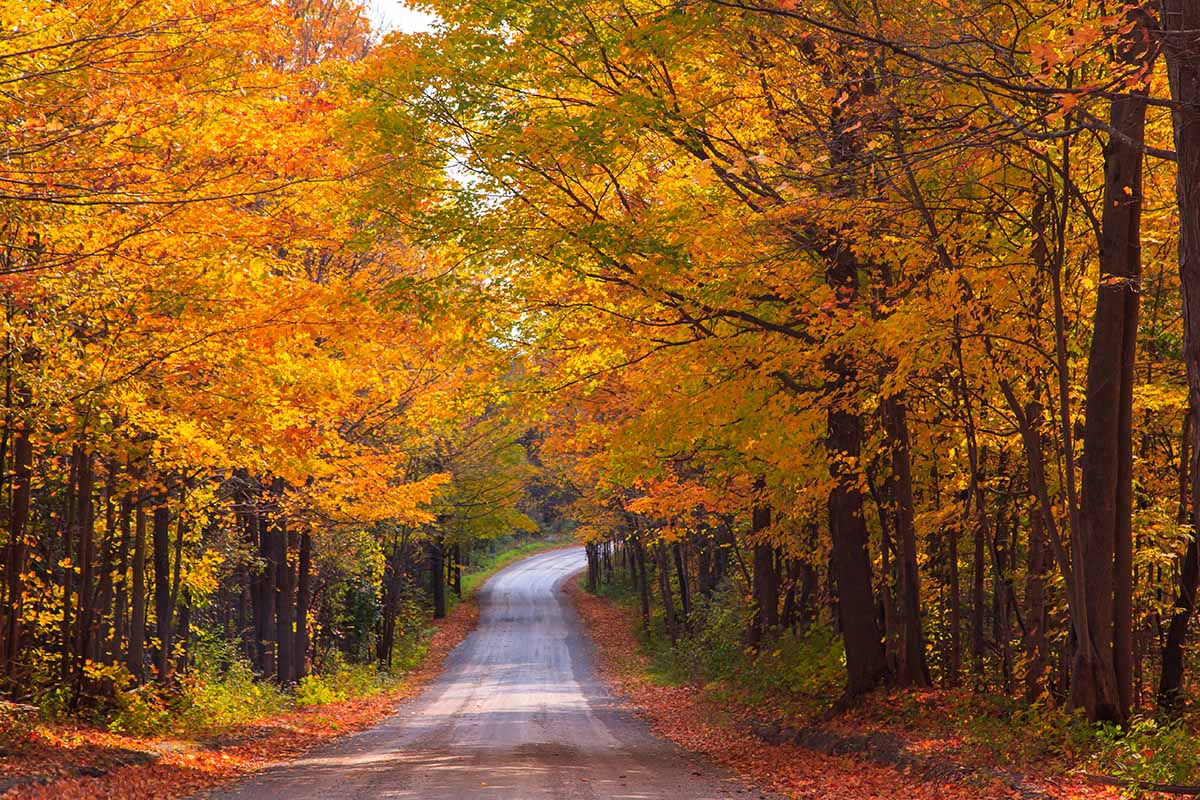
Of course, everyone’s entitled to their opinion. You may think some of these maples are lame, maybe if they’re unsuited to your area, or that others excluded from this list are actually the greatest… and that’s totally cool!
Here’s the top-secret, insider scoop on garden writing: actual “horrible” plants that aren’t worth planting somewhere are pretty hard to come by. One person’s invasive can be another’s treasure, depending on the surroundings.
Except for yellow nutsedge. Those guys are the worst.
Any questions, remarks, or maples you think we’re missing can go in the comments section below!
For more roundups of premium landscape trees to plant at home, check out this smorgasbord of articles next:
